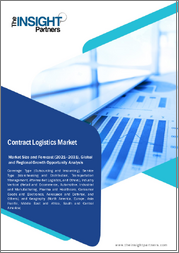
|
시장보고서
상품코드
1768687
미국의 계약 물류 시장 : 서비스별, 유형별, 업종별, 운송 수단별, 지역별, 기회 및 예측(2018-2032년)United States Contract Logistics Market Assessment, By Service, By Type, By Industry Vertical, By Mode of Transportation, By Region, Opportunities and Forecast, 2018-2032F |
||||||
미국의 계약 물류 시장은 E-Commerce 확대, 아웃소싱, 디지털 혁신, 맞춤형 부가가치 서비스에 대한 수요 증가로 인해 2025-2032년 예측 기간 동안 CAGR 4.23%를 기록하며 2024년 552억 3,000만 달러에서 2032년에는 769억 3,000만 달러로 성장할 것으로 예상됩니다. 미국의 계약 물류는 전술적 서비스에서 공급망 관리의 전략적 축으로 성장했습니다. 과거에는 트럭과 창고에 불과했던 것이 이제는 실시간 재고 추적, 자동화된 배송, 역물류, 애프터마켓 지원, E-Commerce 익일 배송, 의약품 냉장 창고, 자동차 애프터마켓 부품 등 복잡한 그물망의 눈과 같은 존재로 변모하고 있습니다. 미국 기업들은 그 어느 때보다 더 빠르고, 낭비 없이, 더 스마트하게 배송할 수 있는 전문가에게 물류를 아웃소싱하고 있습니다.
이 분야는 엔드-투-엔드 컨트롤 타워, AI 통합 창고 관리, 예측 가능한 배송 경로를 제공하는 기업들이 제공하는 풀 서비스 생태계로 성숙하고 있습니다. 이러한 능력은 팬데믹 시대의 공급망 재편, E-Commerce의 성장, 그리고 중요한 제조업의 리쇼어링으로 인해 더욱 가속화되었습니다. 오늘날 물류 제공업체를 차별화하는 것은 이행 속도뿐만 아니라 유연성, 컴플라이언스, 그리고 불안정한 시장에서의 회복력입니다.
예를 들어, 2024년 12월, Saia Inc.는 자회사인 Saia LTL Freight가 Tesla와 제휴하여 Tesla 세미 트럭 2대를 도입했다고 발표했습니다. 한 걸음을 내딛었습니다. 이러한 노력은 Saia가 화물 운송의 미래를 선도하는 리더로서의 입지를 강화하는 것입니다.
목차
제1장 프로젝트 범위와 정의
제2장 조사 방법
제3장 미국 관세의 영향
제4장 주요 요약
제5장 고객의 소리
- 기능과 기타 부가가치 서비스
- IT 인프라 호환성
- 솔루션 효율
- 애프터 서포트
제6장 미국의 계약 물류 시장 전망, 2018-2032년
- 시장 규모 분석과 예측
- 금액별
- 시장 점유율 분석과 예측
- 서비스별
- 운송
- 창고
- 유통
- 애프터마켓 물류
- 유형별
- 인소싱
- 아웃소싱
- 업종별
- 항공우주
- 자동차
- 산업
- 테크놀러지
- 헬스케어
- 소매
- E-Commerce
- 기타
- 운송 수단별
- 철도
- 항공
- 도로
- 수로
- 기타
- 지역별
- 북동부
- 남서부
- 서부
- 남동부
- 중서부
- 기업별 시장 점유율 분석(상위 5개사·기타 - 금액별, 2024년)
- 서비스별
- 2024년 시장 맵 분석
- 서비스별
- 유형별
- 업종별
- 운송 수단별
- 지역별
제7장 수요 공급 분석
제8장 밸류체인 분석
제9장 Porter's Five Forces 분석
제10장 PESTLE 분석
제11장 서비스 가격 모델
제12장 시장 역학
- 시장 성장 촉진요인
- 시장 과제
제13장 시장 동향과 발전
제14장 정책과 규제 상황
제15장 사례 연구
제16장 경쟁 구도
- 시장 리더 상위 5개사 경쟁 매트릭스
- 상위 5개사 SWOT 분석
- 시장 상위 10개사 주요 기업 상황
- UPS Supply Chain Solutions Inc.(United Parcel Service, Inc.)
- Saia, Inc.
- DHL Supply Chain(Deutsche Post DHL Group)
- Landstar System, Inc.
- XPO Logistics, Inc.
- Ryder System, Inc.
- FedEx Supply Chain, Inc.(formerly GENCO)
- Burris Logistics, Inc.
- Ryder Supply Chain Solutions LLP(Ryder System, Inc.)
- Americold Logistics, LLC
제17장 전략적 제안
제18장 조사 회사 소개 및 면책사항
ksm 25.07.22United States contract logistics market is projected to witness a CAGR of 4.23% during the forecast period 2025-2032, growing from USD 55.23 billion in 2024 to USD 76.93 billion in 2032F, owing to an e-commerce expansion, outsourcing, digital transformation, and rising demand for customized and value-added services. Contract logistics in the United States has grown from a tactical service into a strategic pillar of supply chain management. What was once about trucks and warehouses is now a complex web of real-time inventory tracking, automated distribution, reverse logistics, and aftermarket support. Whether it is next-day delivery for e-commerce, cold storage for pharmaceuticals, or aftermarket parts for automotive, United States businesses are outsourcing logistics more than ever to specialists who can deliver faster, leaner, and smarter.
The sector has matured into a full-service ecosystem with players offering end-to-end control towers, AI-integrated warehouse management, and predictive delivery routing. These capabilities have been turbocharged by pandemic-era supply chain restructuring, e-commerce growth, and the reshoring of critical manufacturing. Today, what differentiates a logistics provider is not just fulfillment speed; it is flexibility, compliance, and resilience in a volatile market.
For instance, in December 2024, Saia Inc. announced that its subsidiary, Saia LTL Freight, partnered with Tesla to introduce two Tesla Semi trucks into its fleet. As one of the early adopters of Tesla's electric semi-trucks, Saia is taking a significant step toward sustainable transportation. The initiative reinforces Saia's position as a leader in the future of freight transportation.
Rising Demand for Aftermarket Logistics in Automotive and Industrial Sectors Drives Market Growth
Contract logistics providers in the United States are witnessing strong demand for aftermarket logistics, particularly in automotive and industrial equipment. As vehicles and machinery remain in service longer due to supply chain delays and higher replacement costs, OEMs and suppliers are turning to third-party logistics players to manage complex reverse logistics, spare part distribution, and service center replenishment.
For instance, in April 2024, Ryder System Inc. opened a new multiclient logistics facility near the U.S.-Mexico border to support nearshoring and cross-border trade. While focused on CL distribution and parts handling, it demonstrates expanded aftermarket and supply chain infrastructure.
Similarly, in September 2024, FedEx Corporation expanded its supply chain portfolio by investing in Nimble, an AI-driven robotics firm focused on order fulfillment and inventory automation for SMEs, signaling a strong push into tech-enabled contract logistics.
Growth in Outsourcing of Logistics by E-commerce and Retail Clients to Shape the Market Dynamics
The surge in United States e-commerce has fueled a wave of outsourced logistics contracts, as retailers seek to cut delivery times and reduce fixed costs. Mid-size and enterprise retailers are handing over fulfillment, storage, and last-mile execution to 3PL and 4PL providers with national infrastructure and WMS integration.
In May 2025, DHL (DHL Group) Supply Chain strengthened its capabilities in the United States' ecommerce and retail space by acquiring IDS Fulfillment, adding over 1.3 million sq ft of multi-customer warehousing and distribution space. This move underscores continued growth in outsourced fulfillment services.
DHL Supply Chain also expanded its automated e-commerce campus in Ohio to handle higher peak-season throughput and offer bundled services including pick-pack-ship, returns, and order personalization.
Dominance of Warehousing in the Contract Logistics Service Mix
Among all services, warehousing remains the dominant and most critical component of contract logistics in the United States. As inventory strategies shift from "just-in-time" to "just-in-case," businesses are investing in distributed, tech-enabled storage solutions.
In February 2024, Americold Realty Trust unveiled plans to build its inaugural facility in partnership with Canadian Pacific Kansas City (CPKC), aiming to co-locate Americold's warehouse operations within the CPKC rail network. Americold is investing USD 127 million in the 335,000 square foot facility in Kansas City, Missouri. The company plans to create nearly 190 new jobs in the region.
Also, in November 2024, Saia Inc. launched its newest terminal in Warren, Michigan, reinforcing its strategic growth and "Customer First" approach. The facility aims to deliver enhanced service to the Warren market with reduced transit times and improved freight handling efficiency. This expansion bolsters Saia's presence in Michigan and supports higher service standards for its customers.
Impact of U.S. Tariffs on the United States Contract Logistics Market
Tariffs on imported goods, especially from China, have driven many United States companies to shift from just-in-time to just-in-case inventory strategies. This has led to a surge in demand for domestic warehousing and contract logistics partners who can manage inventory overflow, bonded storage, and real-time tracking.
To avoid volatile tariff structures, manufacturers are increasingly relocating production to Mexico and other nearshore markets. This realignment has boosted cross-border logistics and forced United States contract logistics providers to enhance multimodal capabilities and establish stronger Mexico-United States corridor networks.
Tariff complexity has made compliance a critical service. Contract logistics firms are now expected to offer integrated trade advisory, automated customs filing, and product classification support. Those with embedded compliance tools have become more valuable in mitigating duty exposure and ensuring smooth cargo flow.
Frequent changes in tariff policy have created unpredictability in landed costs. As a result, shippers are demanding more flexible contracts from logistics providers, with volume-based pricing, duty-adjusted terms, and dynamic warehousing options. Providers that can quickly scale up or down are preferred in tariff-sensitive verticals like electronics, automotive, and apparel.
Key Players Landscape and Outlook
The United States contract logistics market is led by a mix of global integrators and specialized national players. Companies offer end-to-end logistics, including freight forwarding, reverse logistics, and AI-driven fulfillment centers. Whereas Ryder System stands out in aftermarket and industrial logistics, XPO focuses on retail and e-commerce-centric clients. Americold is a dominant force in temperature-controlled storage for the food and pharma industries. Landstar, Burris Logistics, and Saia Inc. round out a market increasingly focused on flexibility, automation, and industry-specific expertise. Today's competitive edge comes not from lowest-cost delivery, but from service integration, real-time visibility, and the ability to respond to SKU volatility and seasonal surges. Contract logistics in the United States is no longer about being the biggest-it is about being the most adaptive.
For instance, in June 2025, Landstar System, Inc. provided transportation solutions for Duos Technologies (Duostech), delivering a specialized data center from Duostech's Jacksonville, Florida headquarters. The Edge Data Center is integrated with Duostech's RIP (railcar inspection portal), using AI and advanced camera equipment to detect safety issues on Amtrak high-speed passenger cars. This technology aims to enhance rail safety for both cargo and, in the future, passengers by identifying potential derailment risks before they occur.
Table of Contents
1. Project Scope and Definitions
2. Research Methodology
3. Impact of U.S. Tariffs
4. Executive Summary
5. Voice of Customers
- 5.1. Features and Other Value-added Service
- 5.2. IT Infrastructure Compatibility
- 5.3. Efficiency of Solutions
- 5.4. After-sales Support
6. United States Contract Logistics Market Outlook, 2018-2032F
- 6.1. Market Size Analysis & Forecast
- 6.1.1. By Value
- 6.2. Market Share Analysis & Forecast
- 6.2.1. By Services
- 6.2.1.1. Transportation
- 6.2.1.2. Warehousing
- 6.2.1.3. Distribution
- 6.2.1.4. Aftermarket Logistics
- 6.2.2. By Type
- 6.2.2.1. Insourcing
- 6.2.2.2. Outsourcing
- 6.2.3. By Industry Vertical
- 6.2.3.1. Aerospace
- 6.2.3.2. Automotive
- 6.2.3.3. Industrial
- 6.2.3.4. Technology
- 6.2.3.5. Healthcare
- 6.2.3.6. Retail
- 6.2.3.7. E-commerce
- 6.2.3.8. Others
- 6.2.4. By Mode of Transportation
- 6.2.4.1. Railways
- 6.2.4.2. Airways
- 6.2.4.3. Roadways
- 6.2.4.4. Waterways
- 6.2.4.5. Others
- 6.2.5. By Region
- 6.2.5.1. Northeast
- 6.2.5.2. Southwest
- 6.2.5.3. West
- 6.2.5.4. Southeast
- 6.2.5.5. Midwest
- 6.2.6. By Company Market Share Analysis (Top 5 Companies and Others - By Value, 2024)
- 6.2.1. By Services
- 6.3. Market Map Analysis, 2024
- 6.3.1. By Services
- 6.3.2. By Type
- 6.3.3. By Industry Vertical
- 6.3.4. By Mode of Transportation
- 6.3.5. By Region
7. Demand Supply Analysis
8. Value Chain Analysis
9. Porter's Five Forces Analysis
10. PESTLE Analysis
11. Service Pricing Model
12. Market Dynamics
- 12.1. Market Drivers
- 12.2. Market Challenges
13. Market Trends and Developments
14. Policy and Regulatory Landscape
15. Case Studies
16. Competitive Landscape
- 16.1. Competition Matrix of Top 5 Market Leaders
- 16.2. SWOT Analysis for Top 5 Players
- 16.3. Key Players Landscape for Top 10 Market Players
- 16.3.1. UPS Supply Chain Solutions Inc. (United Parcel Service, Inc.)
- 16.3.1.1. Company Details
- 16.3.1.2. Key Management Personnel
- 16.3.1.3. Products and Services
- 16.3.1.4. Financials (As Reported)
- 16.3.1.5. Key Market Focus and Geographical Presence
- 16.3.1.6. Recent Developments/Collaborations/Partnerships/Mergers and Acquisition
- 16.3.2. Saia, Inc.
- 16.3.3. DHL Supply Chain (Deutsche Post DHL Group)
- 16.3.4. Landstar System, Inc.
- 16.3.5. XPO Logistics, Inc.
- 16.3.6. Ryder System, Inc.
- 16.3.7. FedEx Supply Chain, Inc. (formerly GENCO)
- 16.3.8. Burris Logistics, Inc.
- 16.3.9. Ryder Supply Chain Solutions LLP (Ryder System, Inc.)
- 16.3.10. Americold Logistics, LLC
- 16.3.1. UPS Supply Chain Solutions Inc. (United Parcel Service, Inc.)
Companies mentioned above DO NOT hold any order as per market share and can be changed as per information available during research work.



















